A fragrant, spicy flavor booster, Chiu Chow chili oil tastes best when homemade with fresh ingredients and balanced seasonings.
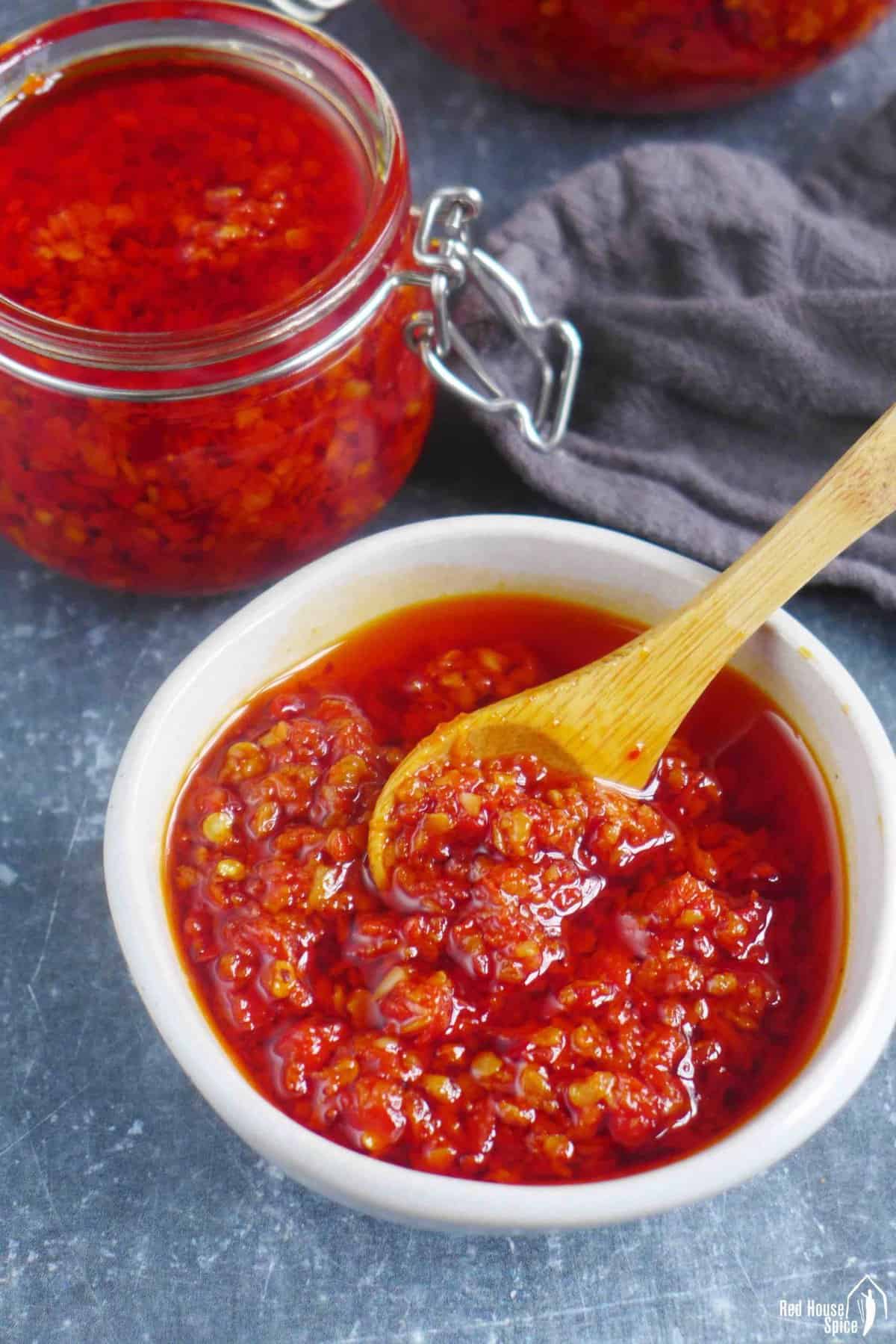
Jump to:
What is Chiu Chow chili oil
When it comes to Chinese kitchen staples, chili oil or hot sauces are hard to ignore. Today’s recipe, Chiu Chow Chili Oil (潮州辣椒油), is an exciting addition to my homemade condiment collection. I’m sure you’ll love it just as much as my recipe for Classic Chinese Chili Oil, one of the most popular posts on this blog.
Chiu Chow (or Chaozhou/潮州) refers to a city in China’s southern Guangdong/广东 province (aka Canton), renowned for its culinary heritage. The chili oil named after this city is rich in garlicky, aromatic flavors with a subtle hint of sweetness.
While ready-made Chiu Chow chili oil is available on store shelves, I find it’s often too salty and lacks fragrance. Now that I’ve perfected this homemade version, I can’t wait to share it with you! After all, nothing beats an additive-free, preservative-free homemade sauce, right?

Compared to other homemade spicy condiments I’ve shared, here’s what makes Chiu Chow chili oil unique:
- It involves frying fresh chili and garlic in hot oil, unlike Chili Garlic Sauce, which doesn’t require cooking.
- It primarily uses fresh chili, setting it apart from Sichuan Chili Oil, which uses only dried chili.
Top Tips
- Choose chili peppers that suit your heat tolerance.
- Fry the ingredients over low heat. Do not rush the process.
- Mind the container hygiene to prolong the life of the sauce.
Ingredients
Here are the ingredients you need to make Chiu Chow chili oil:
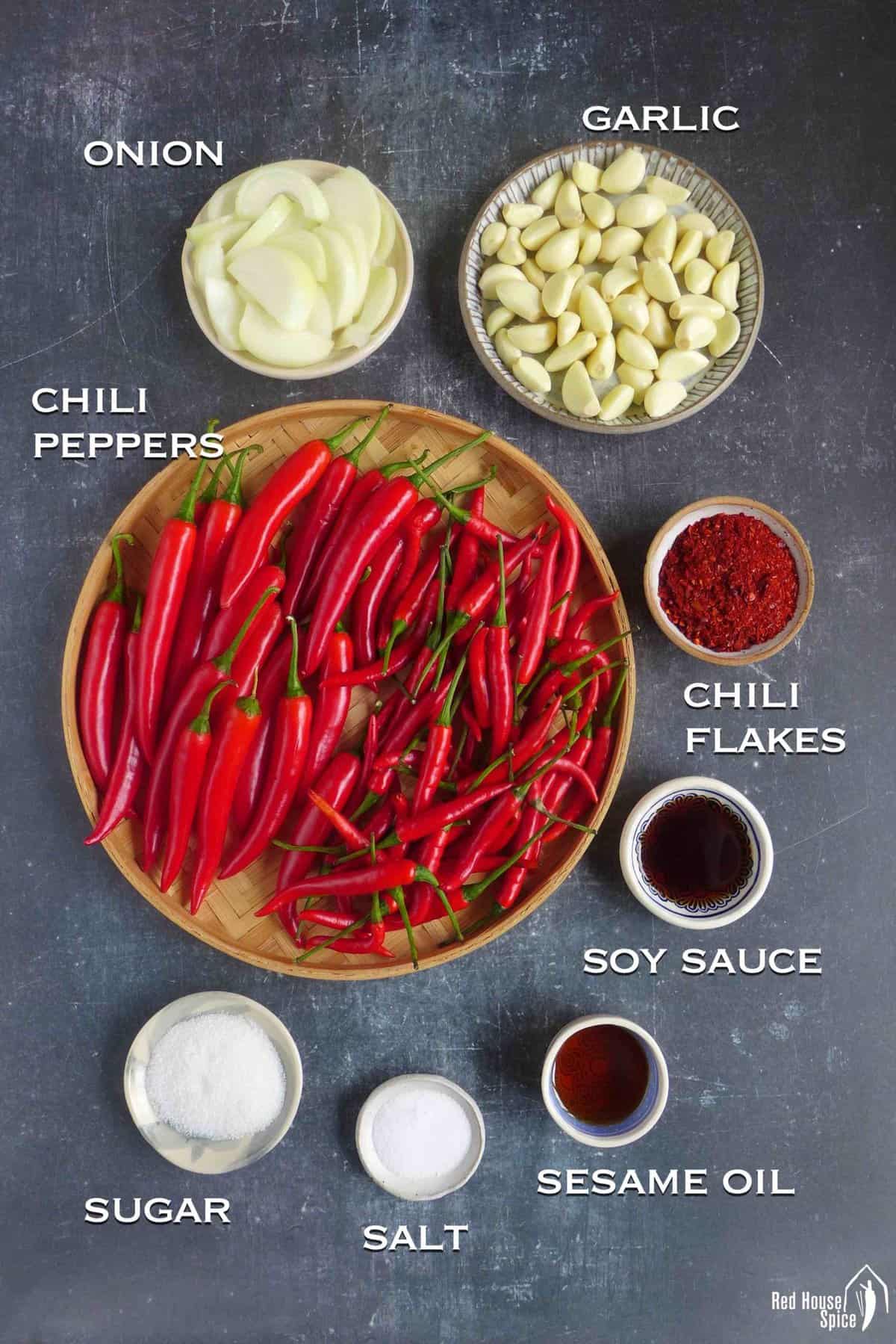
- Fresh chili peppers: See the next section for more details on this key ingredient.
- Chili flakes: Add extra heat and a more vibrant red color.
- Garlic: Be generous with this aromatic booster.
- Onion: Used to infuse the oil.
- Neutral cooking oil: Such as sunflower, canola, corn, or vegetable oil.
- Soy sauce: Adds an umami taste.
- Salt: Enhances the savory flavor and extends the sauce’s shelf life.
- Sugar: Offers a hint of sweetness that complements the heat.
- Sesame oil. Adds extra aroma and a nutty taste.
Note: See the recipe card at the end of the post for quantities.
Choose chili peppers
For my homemade Chiu Chow chili oil, I combined two types of red chili peppers: Dutch red chilies (similar to Fresno pepper, red Jalapeño), which have a mildly hot, slightly sweet taste, and bird’s eye chilies, which bring a much higher level of heat. The ratio I used is about 3 to 2 in weight, creating a medium-high level of spiciness that suits my family’s preferences.
Feel free to use my choices as a reference and select the types of chili peppers that best match your own taste. This also applies to the choice of chili flakes, which can vary in heat level too.
Cooking procedure
Step 1: Prepare the ingredients
Wash the chili peppers under running water, then shake off most of the water. Use a towel to wipe off any remaining liquid on the surface, or let them sit overnight to dry completely. Remove the green stems by ripping or cutting them off. Chop any large peppers into sections.
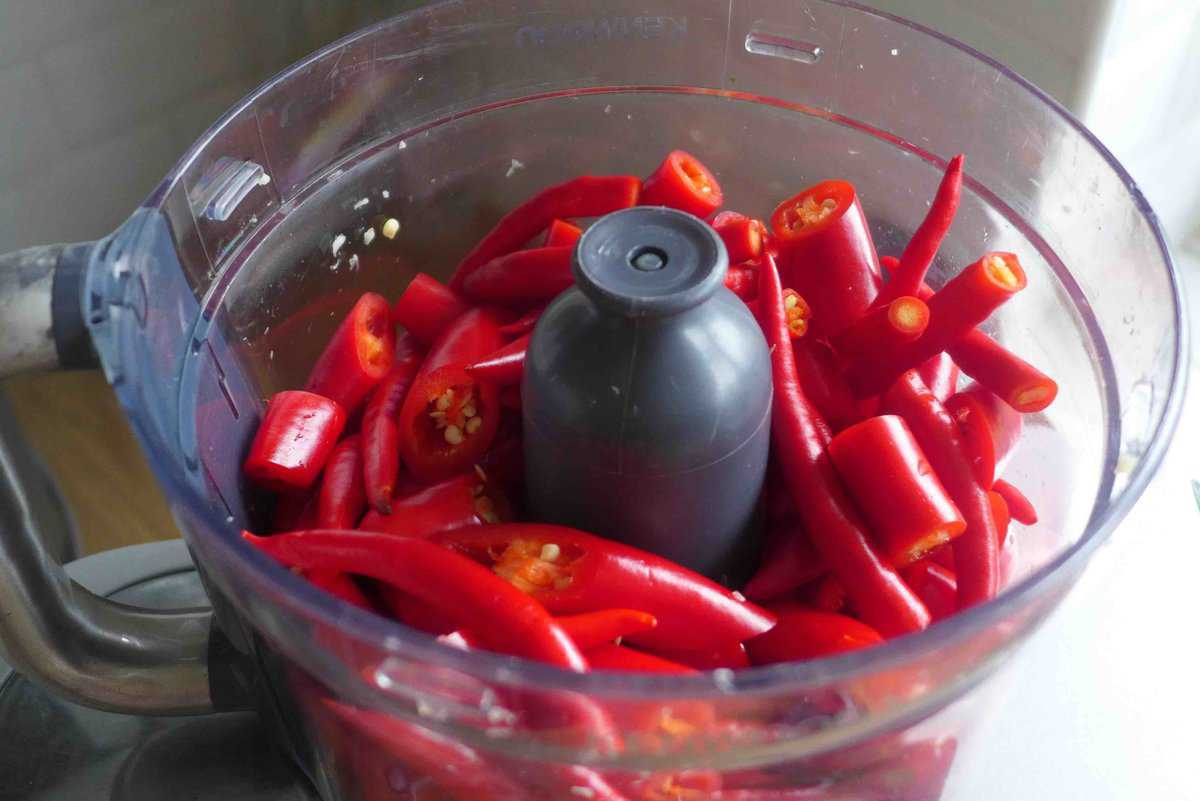
Put the peppers in a food processor. Pulse on high speed in short intervals, checking the texture each time. Stop when the peppers are finely chopped into tiny pieces, but not overly minced into a paste.
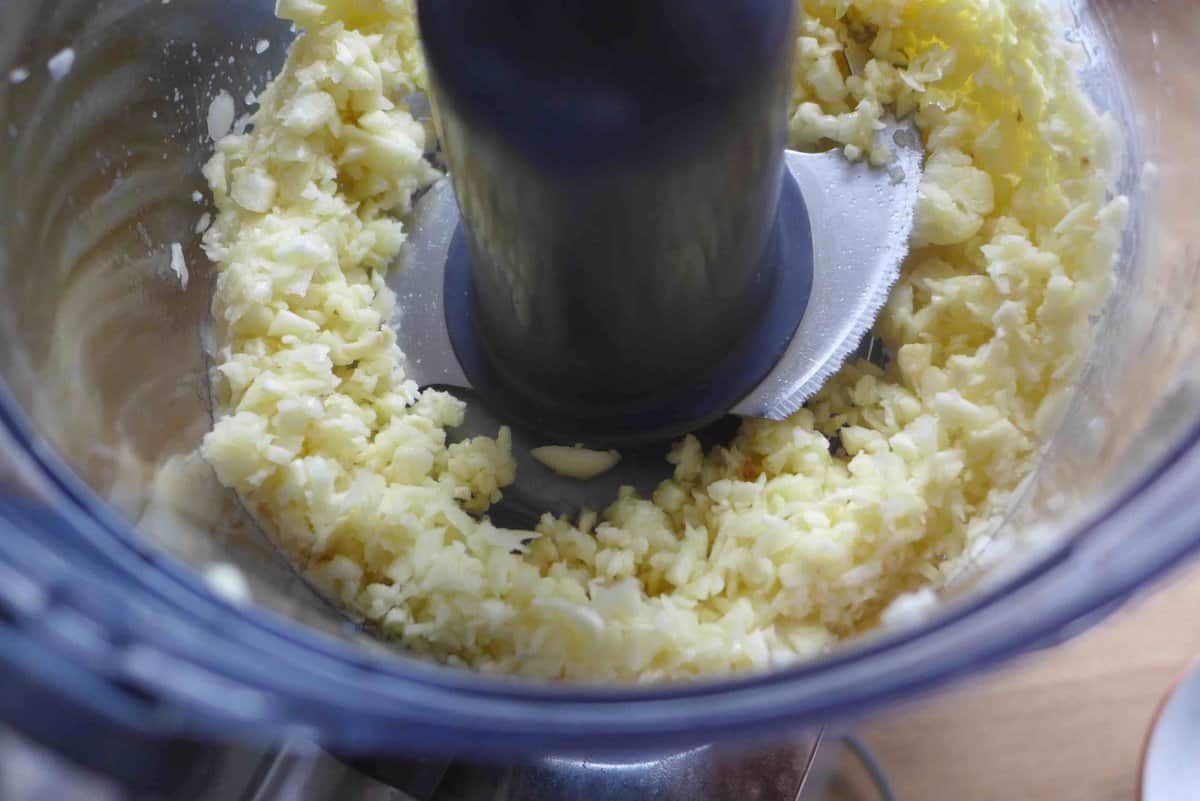
Peel the garlic cloves and use the same method to mince them in the food processor until they achieve a similar texture.
🌟 NOTE: A food processor works best for chopping a large quantity of chili pepper and garlic, as required in this recipe. However, if you plan to make a smaller batch, it’s better to use a mortar and pestle instead for better control over the texture.
Step 2: Infuse the oil
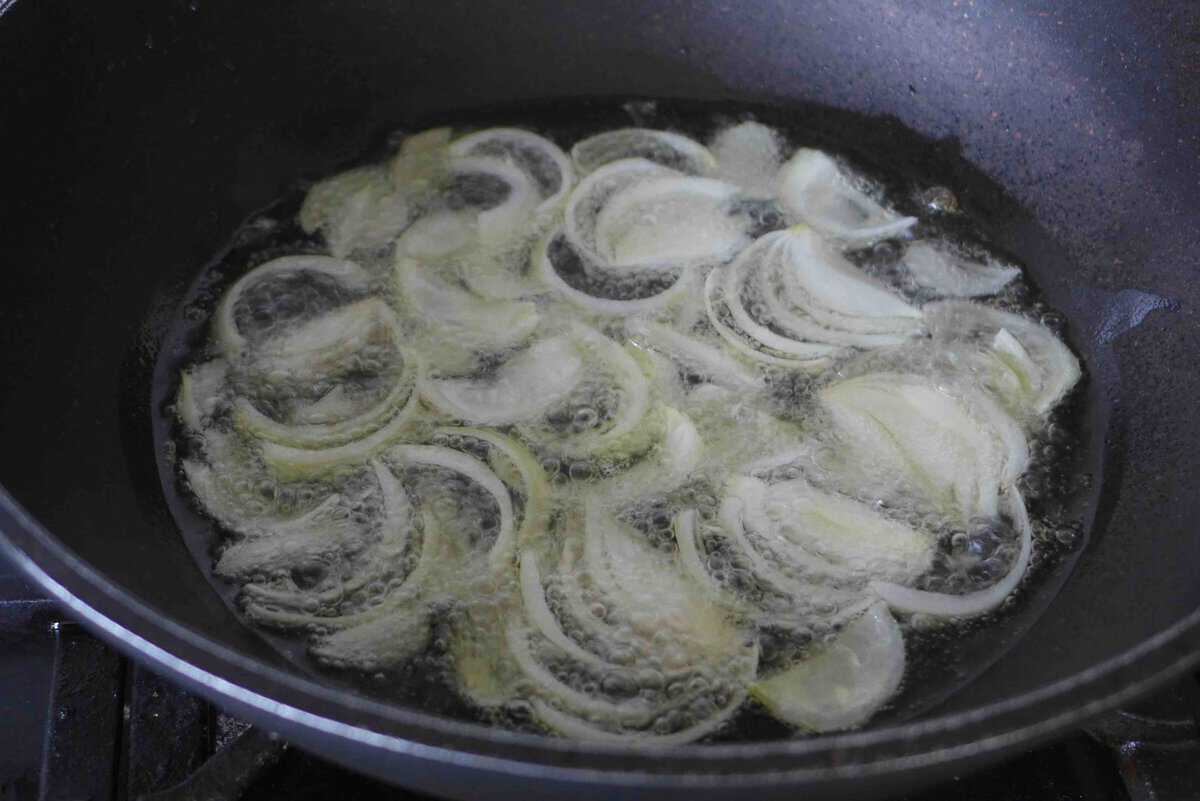
You may use a wok, deep skillet, or saucepan for frying. Pour in the cooking oil, then add the sliced onion immediately. Let it gently fry over medium-low heat. This step infuses the oil with a subtle onion flavor, similar to how Scallion Oil enhances overall flavor.
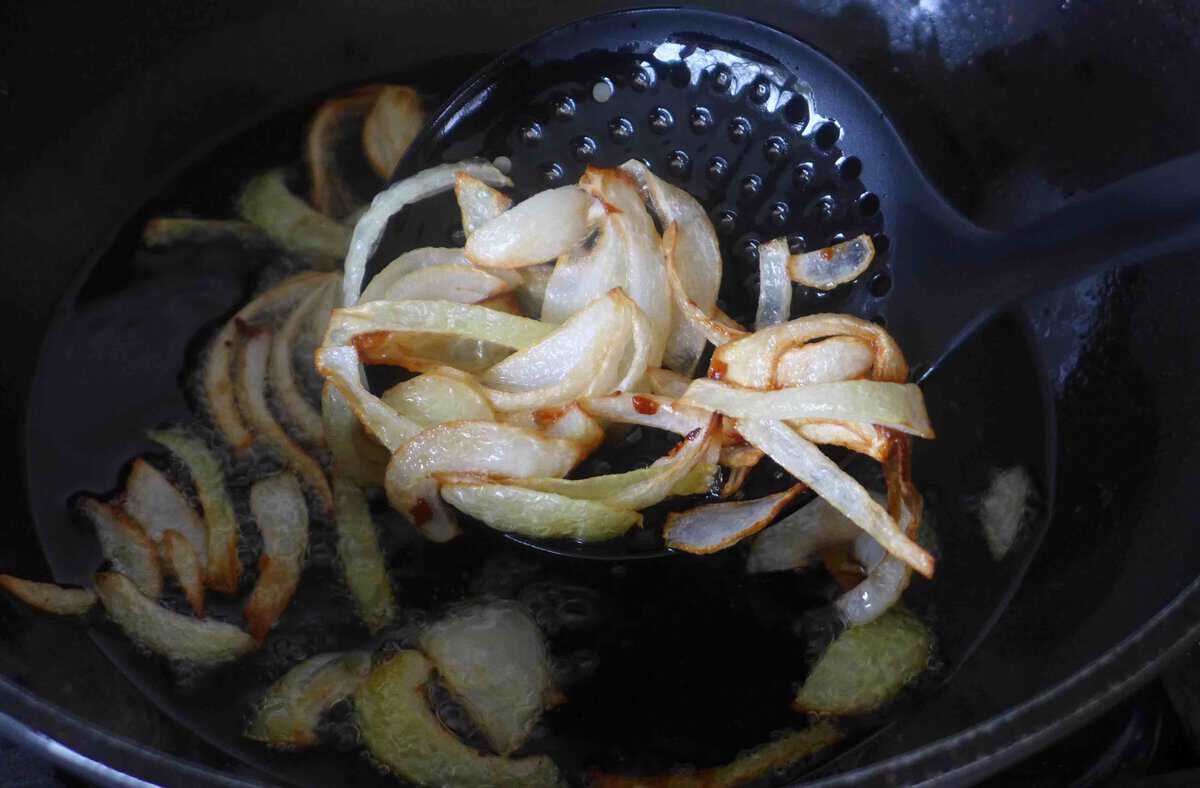
Once the edges of the onion turn golden, use a slotted spoon to remove all the onion pieces.
🌟 NOTE: To avoid waste, you can add the fried onion to any stir-fried dishes or use it as a topping for noodles.
Step 3: Fry pepper and garlic
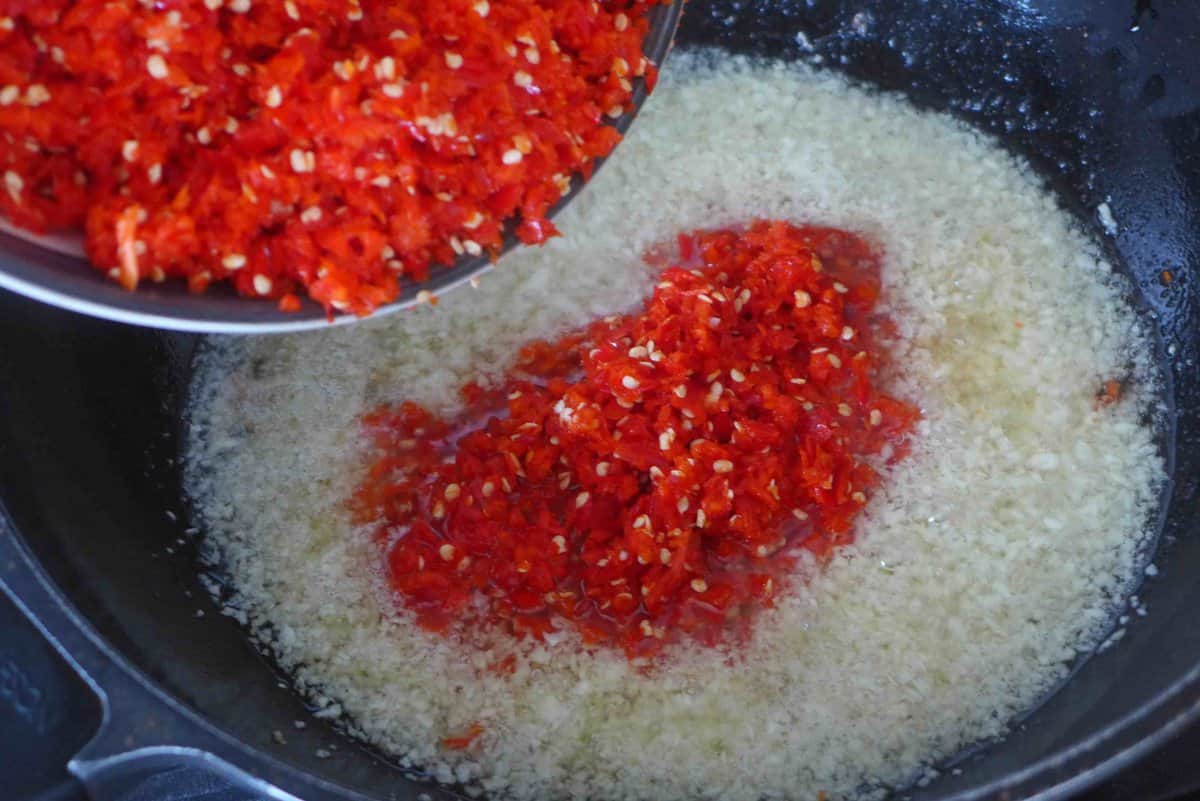
Add the minced garlic and chili peppers to the hot oil. Mix well, then let them fry over low heat, stirring occasionally. Scrape any garlic or pepper pieces clinging to the sides, and make sure the bottom of the mixture isn’t burning.
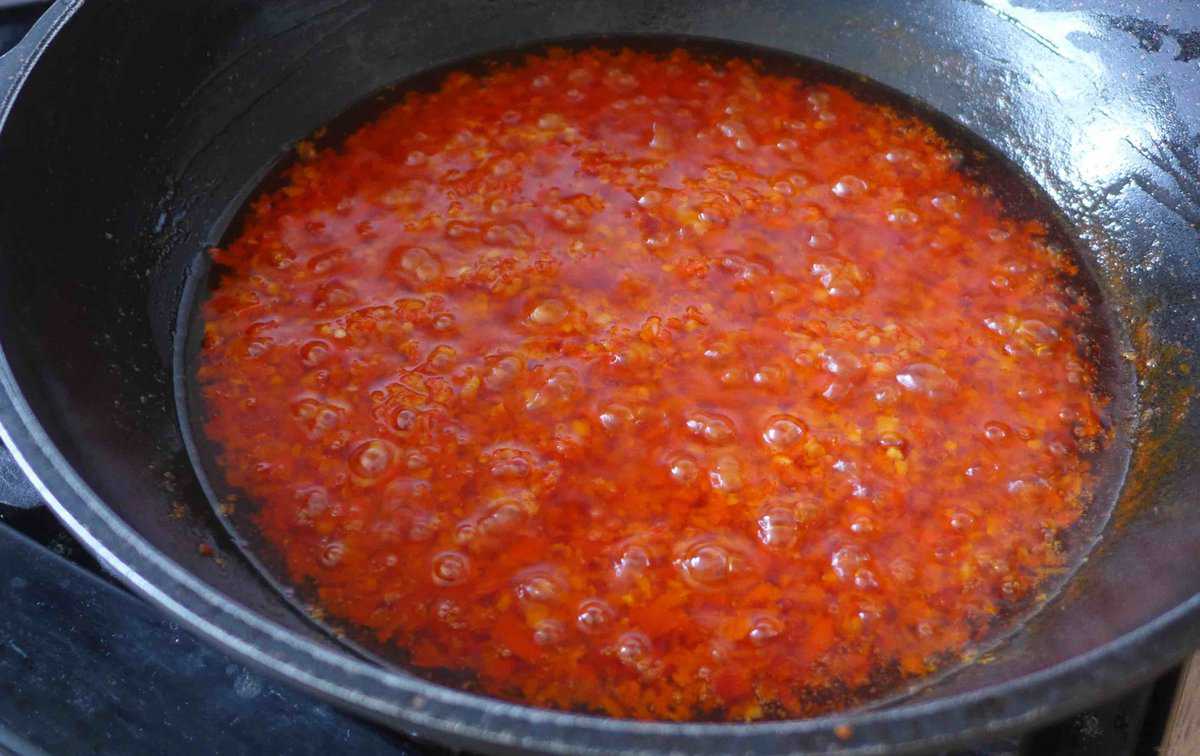
Eventually, you’ll notice the peppers and garlic reduce in size, with a clear separation between the solid bits and the oil.
This process took me about 25 minutes. It may seem long, but patience is key, as the goal is to allow most of the moisture in the peppers and garlic to evaporate, ensuring a longer shelf life for the chili oil.
🌟 NOTE: It’s important to maintain an optimal heat. It should be high enough to fry the ingredients effectively but not so high that they burn quickly. You should see small bubbles forming on the surface, similar to a gentle simmer when slowly cooking something in water.
Step 4: Season the oil
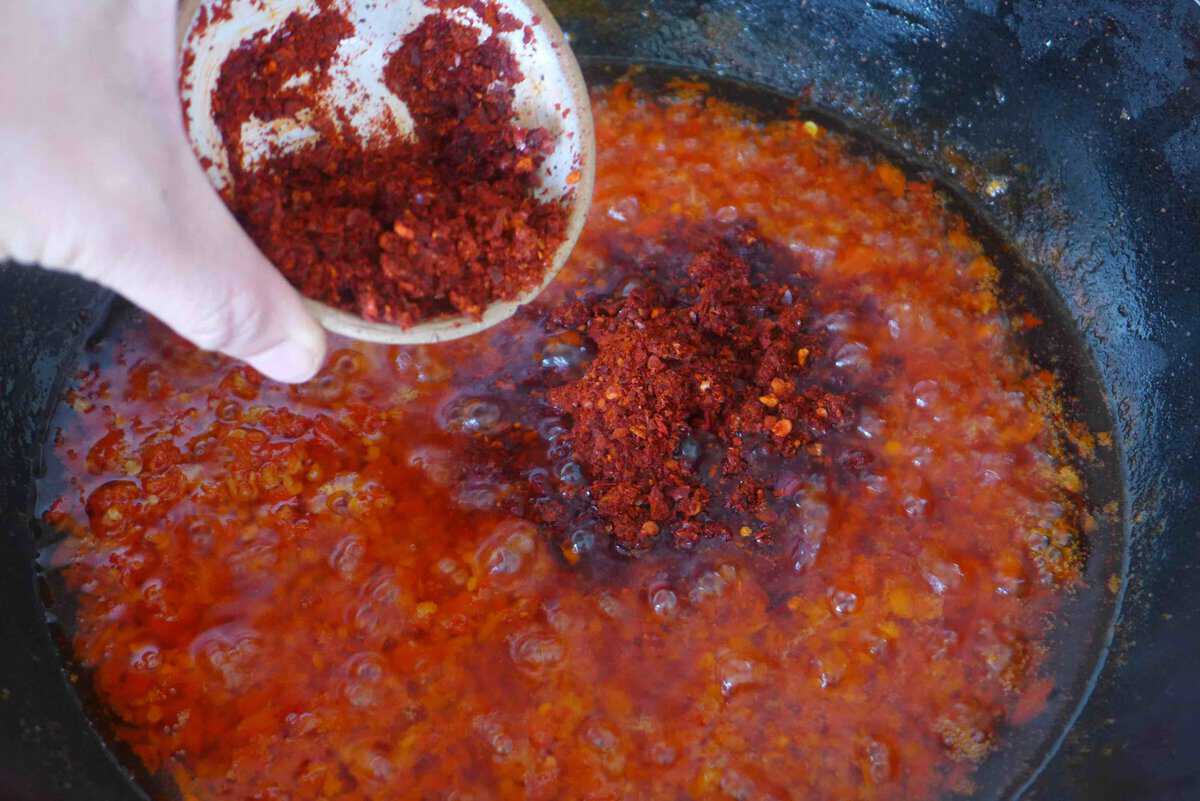
Mix the chili flakes with soy sauce then stir them into the fried pepper. This step helps dampen the flakes so they won’t get burnt in the hot oil.
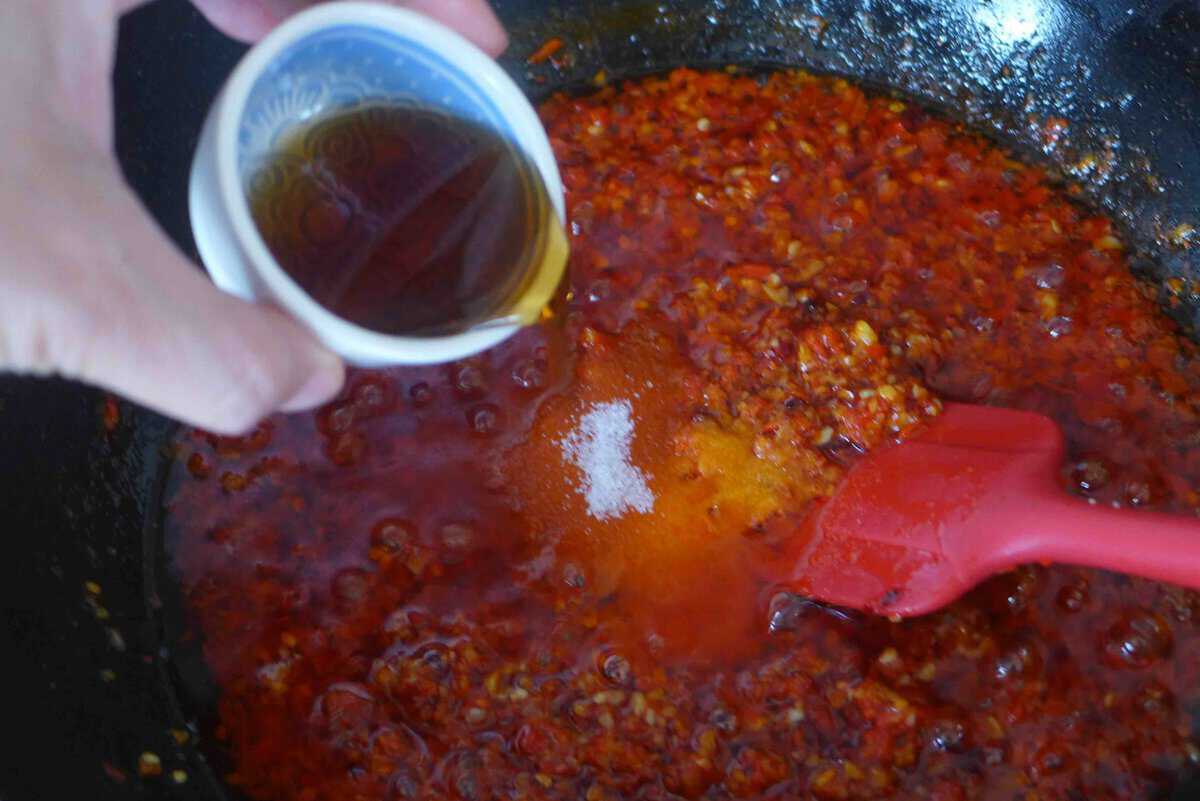
Then, add salt, sugar, and sesame oil. Give everything a thorough mix before removing the cookware from the heat. Let the chili oil cool naturally.
Storage
Transfer the cooled Chiu Chow chili oil to clean, dry, airtight jars or containers. If it will be consumed within 2 weeks (it’s so tasty and versatile that it never lasts long in our Red House), it’s fine to store it on the counter, away from heat sources and direct sunlight.
Alternatively, store the chili oil in the refrigerator for up to 2 months or in the freezer for up to 6 months. The storage duration may vary depending on how thoroughly the moisture was removed during the cooking process. Always inspect the chili oil’s appearance and smell before use to ensure its quality.
How to use it
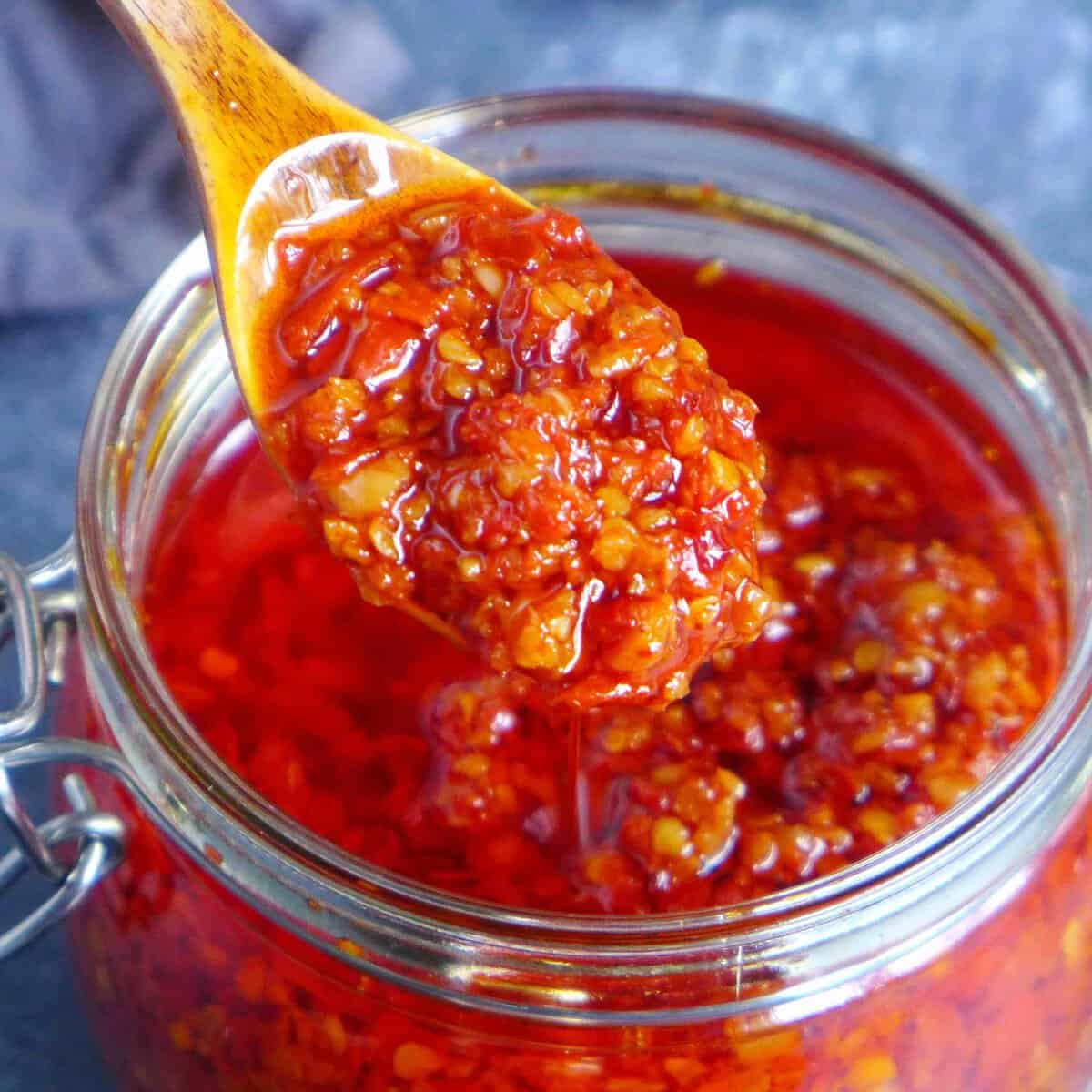
Remember to always use a dry, clean spoon to scoop out the chili oil. It’s best to stir well to mix the oil with the sediment that settles at the bottom of the jar, as this combination provides the best flavor.
Chiu Chow chili oil is incredibly versatile and makes an excellent addition to many dishes. Here are some classic examples:
- Splash it over noodle or rice dishes: It adds extra flavor to Egg Fried Rice, Beef Chow Fun, Lo Mein, or Chicken Noodle Soup.
- Enjoy it as a dipping sauce: Perfect for dumplings, bao buns, and hot pot.
- Smear it over freshly made staples: Delicious on Scallion Pancakes, Plain Steamed Buns, or Zucchini Pancakes.
- Add it to dressings for cold appetizers: Perfect for Sliced Beef Shank, Smashed Cucumber, Scallion Oil Chicken, and more.
- Use it as a side sauce: Ideal for Salt-Baked Chicken, Hainanese Chicken Rice, or Turnip Cake.
- Season stir-fries: Enhances dishes like Hunan Pork, Pepper Steak, or Chop Suey.
Let me know your favorite way to enjoy it—other readers and I would love to be inspired!
Other classic condiments
Looking for more homemade Chinese condiments? Try these popular ones:
📋 Recipe card
Love this recipe? Please leave a 🌟🌟🌟🌟🌟 rating and a comment. Thank you!
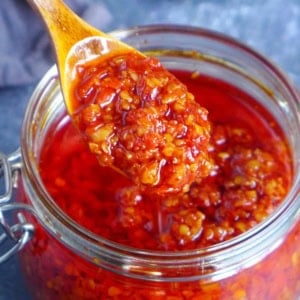
Chiu Chow Chili Oil (潮州辣椒油)
Ingredients
- 1 lb red chili pepper - see note 1
- 6 oz garlic - about 3-5 heads (see note 2)
- 1 onion
- 1½ cup neutral cooking oil
- ¼ cup chili flakes - see note 1
- 1 tablespoon soy sauce
- ½ tablespoon salt
- 1 tablespoon sugar
- 1 tablespoon sesame oil
Instructions
Prepare
- Wash the chili peppers thoroughly and drain well. Pat them dry with paper towels to remove any remaining water on the surface. Remove and discard the stems. If the peppers are large, cut them into sections.
- Use a food processor to chop the peppers into fine pieces, stopping intermittently to check the texture. Avoid over-processing them into a paste. (see note 3).
- Peel all the garlic cloves, then mince them in the food processor to a similar size as the chopped peppers.
- Cut onion into slices.
Fry
- Pour oil into a wok, skillet, or saucepan, and add the sliced onion. Fry over medium-low heat for about 5 minutes, or until the onion is lightly browned on the edges. Remove the onion from the oil using a slotted spoon or chopsticks.
- Add the minced garlic and chili peppers to the oil and fry them gently. Keep the heat low, stirring occasionally. Use a spatula to scrape any garlic or pepper pieces clinging to the sides back into the oil to prevent burning.
- This process takes about 25 minutes. Toward the end, you’ll notice the garlic and peppers have reduced in size, and there’s a clear separation between the oil and the solid bits.
Season
- Mix chili flakes with soy sauce, then put the mixture into the wok. Gently stir for 30 seconds or so.
- Add salt, sugar, and sesame oil, and give everything a final stir before turning off the heat.
Store
- Let the chili oil cool completely. Transfer it to dry, clean jars or containers with an airtight seal.
- Store the chili oil in the refrigerator for up to 2 months, or in the freezer for up to 6 months (see note 4). Always use a dry, clean spoon to scoop out the chili oil to prevent contamination.
NOTES
NUTRITION
NUTRITION DISCLOSURE: Nutritional information on this website is provided as a courtesy to readers. It should be considered estimates. Please use your own brand nutritional values or your preferred nutrition calculator to double check against our estimates.

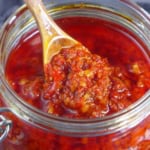
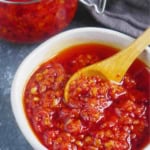
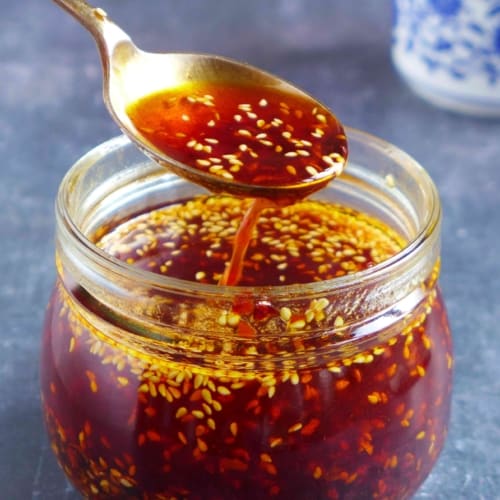
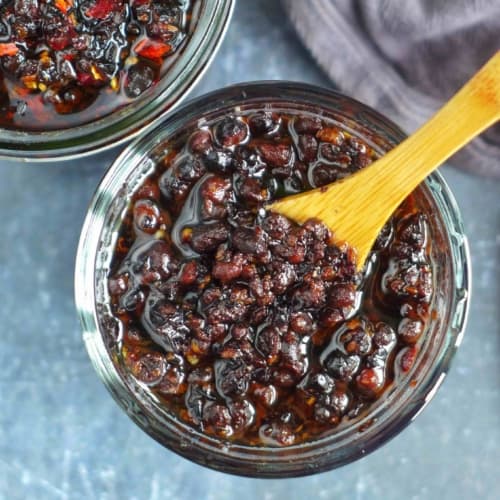
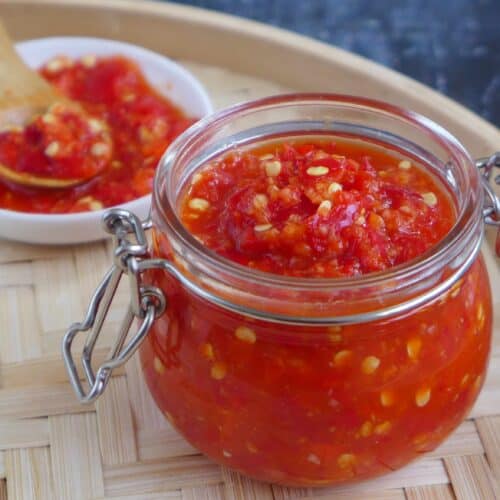
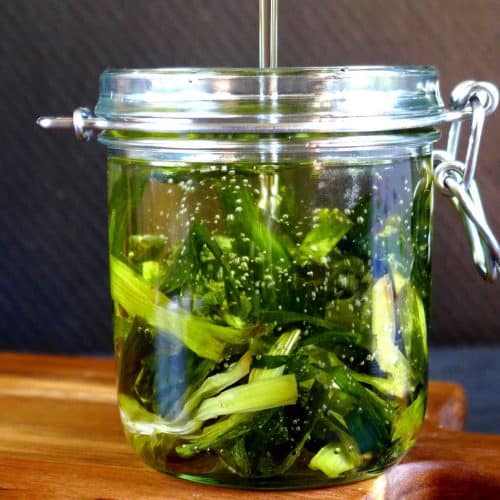
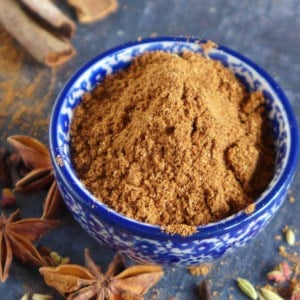
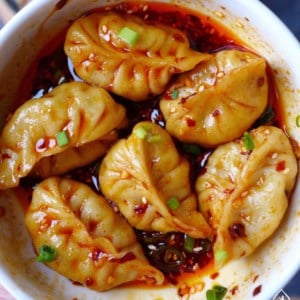
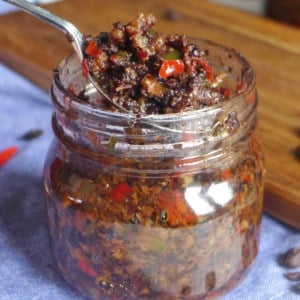
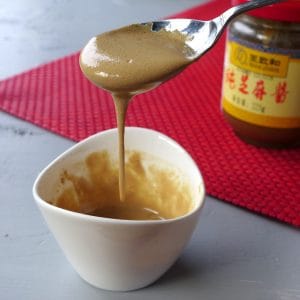
Hi Wei,
thank you so much for another great recipe. I am giving it 4stars instead of 5 as it is fiery!! I used mild to spicy (thai) chillies in the ration of 4:1 (instead of 3:2) and also left out the chilli flakes but it’s still “blow your head off” spicy for me and I can barely taste the garlic behind the “fire” 😀 Also, I am by now so used to your chilli oil recipe that i really miss that depth of flavour that comes from the various spices used.
I will try making this again with only 10% de-seeded thai chillies and a bit more garlic. Do you think adding spices to the oil with the onions would work? If yes, which spices would you recommend? Also, i now have a lot of frozen thai chillies. Can I use these to make chiu chow sauce?
Thanks in advance for your anwer 🙂
Love,
Raz
Thanks for your feedback, Razia! You can infuse the oil with spices like star anise, cinnamon, and Sichuan peppercorns for more depth, similar to my classic chili oil recipe. Frozen Thai chilies work fine for Chiu Chow chili oil—just thaw them slightly. Adjusting the chili ratio and adding more garlic should help balance the heat to suit your own taste. Hope your next batch is perfect!
Excellent, thank you for your response 🙂
Delicious, thank you for sharing this recipe! Just like we used to enjoy in China!
Thank you so much, Kate! So happy to hear this recipe brought back memories of your time in China. It’s the best compliment to know it captures that authentic taste!
I agree with you that the jarred chilli oil is always so salty that I can’t really taste other flavours. So happy I made your recipe. It turned out so delicious. I’m putting it into all my dishes. Won’t buy it any more!
Thank you! I’m so glad you enjoyed the recipe and found it flavorful. Homemade chili oil really does make all the difference—enjoy adding it to everything!
I have just made this chilli oil and am wondering whether the garlic I used was too much; 5 heads of garlic when peeled yielded 322gm. This is our Australian garlic where the bulbs are quite large. Did you use Chinese garlic where the bulbs are much smaller? You have recommended cooling the chilli oil completely before bottling; is it not possible to bottle immediately when cooked into sterilised jars? Lastly, how long should the chilli oil be left to infuse before using it?
Thank you, Susan, for your thoughtful questions! Yes, I use smaller garlic bulbs, so your yield of 322g from 5 heads is larger than mine. I’ll update the recipe with weight measurements—thanks for pointing that out!
It’s better to let the chili oil cool completely before bottling to prevent condensation and ensure safe handling. For the best flavor, I like letting it infuse for at least 12 hours before using. I hope you enjoy your chili oil!
Thanks, Wei for amending the recipe and I’ll do the same for my copy. I note that the garlic is about half of what had been used; no wonder mine was too garlicky! From this one recipe I filled 3 jars of the size of the Lee Kum Kee spice paste jars so it’ll take a while to finish. I hope to do better the next time!